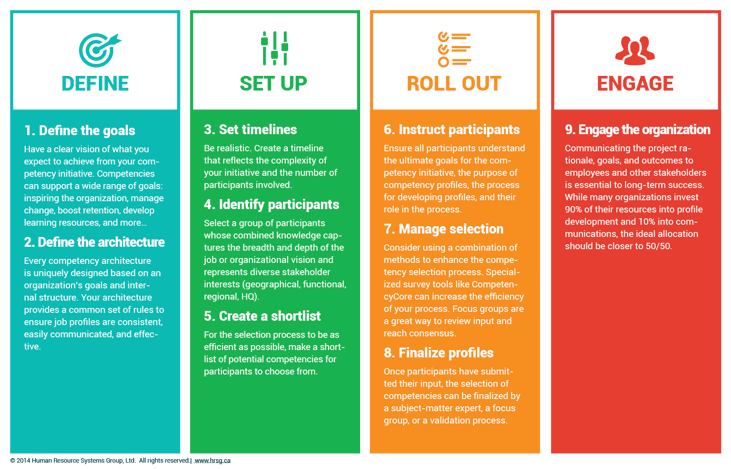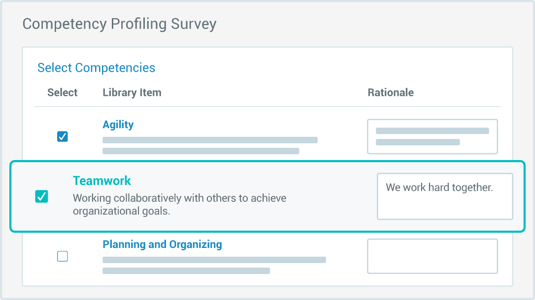Sarah Beckett
What is Competency Profiling?
Competency profiling is the process of selecting industry relevant competencies at a specific level of proficiency required for successful performance in a job. Traditionally, competency profiling initiatives are a multi-step process involving interviews, surveys, focus groups and card sort activities.

HRSG’s nine-step process has been developed and refined during 25 years of competency-based engagements with clients in a wide range of industries.
In this blog post, we define HRSG's competency profiling process which also involves the techniques and tools used in assessment, levels of competence, the role of performance management, personal development plans and competency based training (CBT) in ensuring proper implementation.
9 Steps to Creating Competency Profiles
- Define Your Organizational Goals.
Have a clear vision of what you expect to achieve from your competency initiative. Competencies can support a wide range of goals such as inspiring your organization, managing change, boosting retention, developing learning resources and more. - Define Your Competency Architecture.
What is a competency architecture?
A competency architecture provides a set of rules for guiding the selection of competencies and proficiency levels required for every job profile in the organization.
Every competency architecture is uniquely designed based on an organization's goals and internal structure. Your competency architecture provides a common set of rules to help ensure consistency, ease of communication and effectiveness for any job competency profile you create. - Set Realistic Timelines.
Be realistic. Create a timeline that properly reflects the complexity of your competency initiative and the number of participants involved. - Identify Your Participants.
It is important to select a group of participants from your organization. The combined knowledge of these individuals should capture the breadth and depth of the job or organizational vision. It should also represent your diverse stakeholder interests (geographical, functional, regional, HQ). - Create A Competency Shortlist.
For the selection process to be as efficient as possible, make a short list of potential competencies for your participants to choose from. - Properly Instruct Your Participants.
Ensure all participants understand the ultimate goals for the competency initiative, the purpose of competency profiles, the process for developing profiles, and their role in the overall process. - Manage Your Competency Selection Process.
Consider using a combination of methods to enhance the competency selection process. Specialized software survey tools like CompetencyCore can help increase the efficiency of your process. Focus groups are also a great way to review input and reach consensus.
*Screenshot of competency profiling survey. - Finalize Your Competency Profiles.
Once your participants have submitted their input, the selection of competencies can be finalized by a subject-matter expert, a focus group or a proper validation process. - Engage Your Organization.
Communicating the project rationale, goals, and outcomes to employees and other stakeholders is essential to your project's long-term success.
While many organizations invest 90% of their resources into job competency profile development and 10% into communications , the ideal allocation should be closer to 50/50.
Video: How to create a Competency Profile in less than 2 minutes!
Test out our AI-powered competency profiling tool by pasting any job description of your choice and see the top 5 competencies associated with that job description.
Want to learn how Adaptavist saved hundreds of hours on competency profiling? Check out this Case Study:
Download this Case Study by using the form below.
Learn More About Competency Profiling:
- [Video] Archived Webinar: Best Practices for Competency Profile Development
- How Are Competency-based Job Profiles Used In HR?
Post last updated: January 8, 2021


Submit a Comment